
Some stories posted on The Smokey Generation are exhilarating, some are inspiring, while others are simply entertaining. The common thread? They all are about wildland fire – which has it’s own unique language and vernacular. This page is dedicated to providing context around some of the great stories that have been collected and shared on this website. To learn bits and pieces of the terminology, and to understand some of the context, simply hover your mouse over any orange text to see a tooltip with an explanation, definition, and/or photo.
Every story posted on the Contextualized Story page will also showcase a video of the interviewee telling the story, as well as a word cloud at the bottom of the story, showcasing some of the most commonly used terms contained within the story itself. Hope you enjoy!
A Tough Burn Show
Story by Adam Hernandez, Hotshot Captain
Interviewed May, 2014
I think one that stands out was a burn operation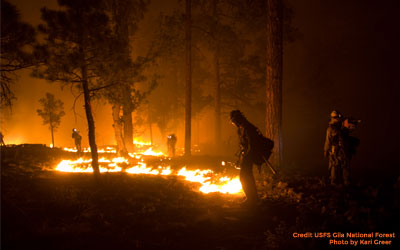 NWCG Definition of Firing Out (often called a “burn show” or “burn operation”): The act of setting fire to unburned fuels located between the control line and main fire in burning out operations. that we had in Idaho. This is in 2007 and we got to the fire and, you know, conditions were really bad for going direct
NWCG Definition of Firing Out (often called a “burn show” or “burn operation”): The act of setting fire to unburned fuels located between the control line and main fire in burning out operations. that we had in Idaho. This is in 2007 and we got to the fire and, you know, conditions were really bad for going direct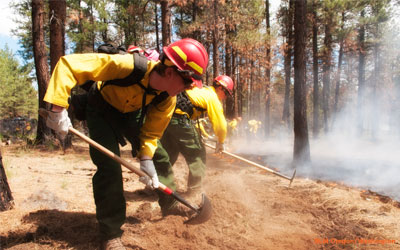 NWCG Definition of Direct Attack/Direct Line: Any treatment applied directly to burning fuel such as wetting, smothering, or chemically quenching the fire or by physically separating the burning from unburned fuel.. The fire behavior was just something—you just couldn’t get right close to it—so it was a lot of indirect
NWCG Definition of Direct Attack/Direct Line: Any treatment applied directly to burning fuel such as wetting, smothering, or chemically quenching the fire or by physically separating the burning from unburned fuel.. The fire behavior was just something—you just couldn’t get right close to it—so it was a lot of indirect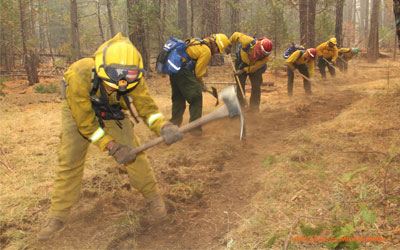 NWCG Definition of Indirect Attack/Indirect Line: A method of suppression in which the control line is located some considerable distance away from the fire’s active edge. Generally done in the case of a fast-spreading or high-intensity fire and to utilize natural or constructed firebreaks or fuelbreaks and favorable breaks in the topography. The intervening fuel is usually backfired; but occasionally the main fire is allowed to burn to the line, depending on conditions. stuff and lot of scratching heads, figuring out where we’re going to go as far as burning
NWCG Definition of Indirect Attack/Indirect Line: A method of suppression in which the control line is located some considerable distance away from the fire’s active edge. Generally done in the case of a fast-spreading or high-intensity fire and to utilize natural or constructed firebreaks or fuelbreaks and favorable breaks in the topography. The intervening fuel is usually backfired; but occasionally the main fire is allowed to burn to the line, depending on conditions. stuff and lot of scratching heads, figuring out where we’re going to go as far as burning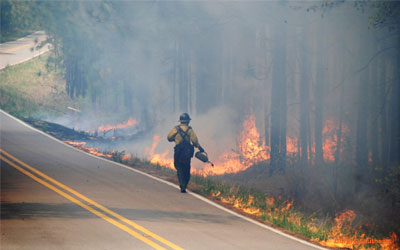 NWCG Definition of Burning Out: Setting fire inside a control line to consume fuel between the edge of the fire and the control line. goes, and stuff like that.
NWCG Definition of Burning Out: Setting fire inside a control line to consume fuel between the edge of the fire and the control line. goes, and stuff like that.
They had tried some burning a couple days before, but were unsuccessful due to spotting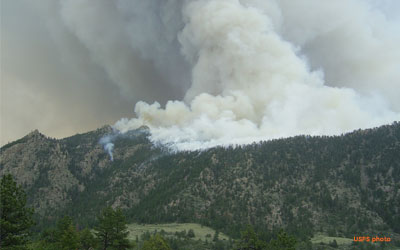 NWCG Definition of a Spot Fire: Fire ignited outside the perimeter of the main fire by a firebrand. and, like I said, it was just way too much fire behavior in the daytime. We were out on a day shift and we were trying to come up with a plan of attack for the day. We knew we were going to have to burn; so with some discussion with our Superintendent and the Division SupervisorNWCG Definition of a Division/Group Supervisor: The ICS position responsible for supervising equipment and personnel assigned to a division or group. Reports to a Branch Director or Operations Section Chief. Division: Divisions are used to divide an incident into geographical areas of operation., we decided that it would probably be best to roll us over into night shift (since we had a good lay of the land from scouting it all day) – roll us over into night shift and then we would do the burn show at night, just burn all through the night.
NWCG Definition of a Spot Fire: Fire ignited outside the perimeter of the main fire by a firebrand. and, like I said, it was just way too much fire behavior in the daytime. We were out on a day shift and we were trying to come up with a plan of attack for the day. We knew we were going to have to burn; so with some discussion with our Superintendent and the Division SupervisorNWCG Definition of a Division/Group Supervisor: The ICS position responsible for supervising equipment and personnel assigned to a division or group. Reports to a Branch Director or Operations Section Chief. Division: Divisions are used to divide an incident into geographical areas of operation., we decided that it would probably be best to roll us over into night shift (since we had a good lay of the land from scouting it all day) – roll us over into night shift and then we would do the burn show at night, just burn all through the night.
Soon as we got the word—it was probably, I don’t know, maybe three o’clock in the afternoon when we came up with the decision to do that—we decided to bed the crew down. Everybody was going to try to get some rest right there where we were, so there were guys just laying out on the road or whatever. You know, on the dirt road (there was no traffic going in and out so it was alright, we were in a safe spot). Everybody kind of just crashed out and tried to get some rest, which is hard to do at three o’clock in the afternoon when it’s super hot.
So we did that, and then later on in the evening we started getting everything together, our equipment NWCG Definition of a Drip Torch and Fusee (firing devices/equipment most commonly used during burnout operations): Drip Torch: Hand-held device for igniting fires by dripping flaming liquid fuel on the materials to be burned; consists of a fuel fount, burner arm, and igniter. Fusee: A colored flare designed as a railway warning device, widely used to ignite backfires and other prescribed fires. and stuff. It was probably about a two miles section, if I remember correctly, of road that we were going to burn off of
NWCG Definition of a Drip Torch and Fusee (firing devices/equipment most commonly used during burnout operations): Drip Torch: Hand-held device for igniting fires by dripping flaming liquid fuel on the materials to be burned; consists of a fuel fount, burner arm, and igniter. Fusee: A colored flare designed as a railway warning device, widely used to ignite backfires and other prescribed fires. and stuff. It was probably about a two miles section, if I remember correctly, of road that we were going to burn off of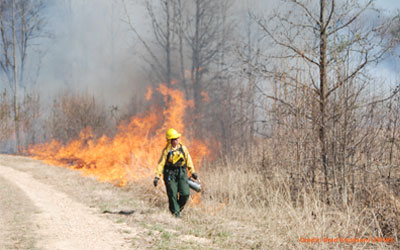 Roads are often used to burn from because they are ready-made control lines.. And so, soon as everything was rightNWCG Definition of Burning Conditions: The state of the combined factors of the environment that affect fire behavior in a specified fuel type. He is most likely referring to burning conditions when he states,”everything was right.”, we grabbed all our burn equipment and went out and started burning. We had folks just working our way across
Roads are often used to burn from because they are ready-made control lines.. And so, soon as everything was rightNWCG Definition of Burning Conditions: The state of the combined factors of the environment that affect fire behavior in a specified fuel type. He is most likely referring to burning conditions when he states,”everything was right.”, we grabbed all our burn equipment and went out and started burning. We had folks just working our way across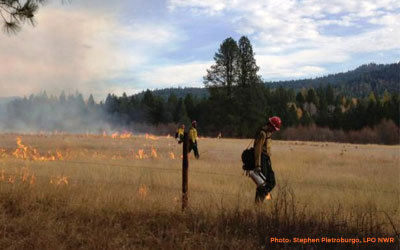 NWCG Definition of Firing Technique and Ignition Pattern: Firing Technique: Any method or pattern of igniting a wildland area to consume the fuel in a prescribed pattern. E.g., heading or backing fire, spot fire, strip-head fire, and ring fire. Ignition Pattern: The distance between ignition lines or points and the sequence of igniting them is determined by weather, fuel, topography, firing technique, and other factors which influence fire behavior and fire effects. and it was going really good, everything was going really well.
NWCG Definition of Firing Technique and Ignition Pattern: Firing Technique: Any method or pattern of igniting a wildland area to consume the fuel in a prescribed pattern. E.g., heading or backing fire, spot fire, strip-head fire, and ring fire. Ignition Pattern: The distance between ignition lines or points and the sequence of igniting them is determined by weather, fuel, topography, firing technique, and other factors which influence fire behavior and fire effects. and it was going really good, everything was going really well.
This was kind of a pretty critical chunk of line that we were trying to get buttoned up and then it [would] set us a good anchor point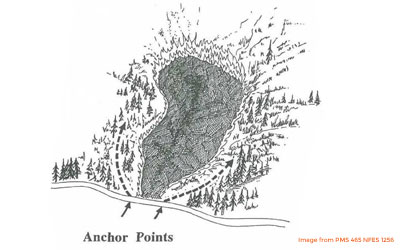 NWCG Definition of Anchor Point: An advantageous location, usually a barrier to fire spread, from which to start constructing a fireline. The anchor point is used to minimize the chance of being flanked by the fire while the line is being constructed. to just keep moving for the rest of the fire. We started off and it was going really good; we’re cruising along, going through a lot of fuelFuel used for a drip torch is generally a mixture of diesel and gasoline.. We had guys taking jerry cans
NWCG Definition of Anchor Point: An advantageous location, usually a barrier to fire spread, from which to start constructing a fireline. The anchor point is used to minimize the chance of being flanked by the fire while the line is being constructed. to just keep moving for the rest of the fire. We started off and it was going really good; we’re cruising along, going through a lot of fuelFuel used for a drip torch is generally a mixture of diesel and gasoline.. We had guys taking jerry cans A five gallon fuel canister with an adjustable spout. Used to transport and fill other devices. Weighs approximately 40 pounds when full. up the hill to top-off the burners
A five gallon fuel canister with an adjustable spout. Used to transport and fill other devices. Weighs approximately 40 pounds when full. up the hill to top-off the burners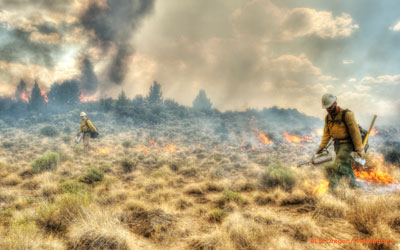 A burner is person responsible for implementing the firing techniques during a burning operation. Usually they use a drip torch, fusee, or other firing device to put fire on the ground in a controlled fashion.. There was one guy in particular that I remember, that I saw him all night long just humpingA term used to convey carrying something (usually something heavy or over a long distance). these jerry cans up and down the hill. And I remember towards the latter morning—probably around six o’clock when we were getting ready to finish up—we were looking for fuel and this guy was still carrying it, all the way from like, I don’t know, from seven o’clock in the evening all the way, just back and forth. That was kind of, kind of crazy…you get guys like that on occasion.A compliment indicating strength and endurance.
A burner is person responsible for implementing the firing techniques during a burning operation. Usually they use a drip torch, fusee, or other firing device to put fire on the ground in a controlled fashion.. There was one guy in particular that I remember, that I saw him all night long just humpingA term used to convey carrying something (usually something heavy or over a long distance). these jerry cans up and down the hill. And I remember towards the latter morning—probably around six o’clock when we were getting ready to finish up—we were looking for fuel and this guy was still carrying it, all the way from like, I don’t know, from seven o’clock in the evening all the way, just back and forth. That was kind of, kind of crazy…you get guys like that on occasion.A compliment indicating strength and endurance.
We continued our burn, took it all the way around, and finally we ended our burn show NWCG Definition of Firing Out (often called a “burn show” or “burn operation”): The act of setting fire to unburned fuels located between the control line and main fire in burning out operations. probably around six o’clock [in the morning]. So, we started it maybe seven o’clock in the evening, maybe eight o’clock, and burned all the way until then. Everything went awesome; everybody was super stoked; didn’t have any issues, you know, minimal spotting. And so we were pretty stoked.
NWCG Definition of Firing Out (often called a “burn show” or “burn operation”): The act of setting fire to unburned fuels located between the control line and main fire in burning out operations. probably around six o’clock [in the morning]. So, we started it maybe seven o’clock in the evening, maybe eight o’clock, and burned all the way until then. Everything went awesome; everybody was super stoked; didn’t have any issues, you know, minimal spotting. And so we were pretty stoked.
Dead tired, you know, we get back in the buggy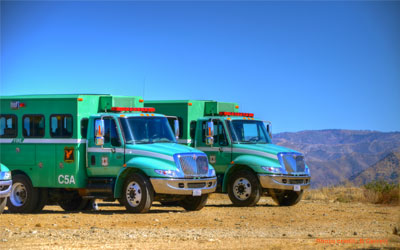 Often called a crew carrier, crew haul, or crew buggy. It’s a vehicle designed to transport ten to twelve individuals and their equipment.. They were kind of utilizing me as the Firing Boss, and I get back in the buggy and there are guys just laid out everywhere. Just exhausted; tired from the shift. When I opened the door to the buggy and looked in, they all kind of sat up and stirred, and looked at me. And I was like, “Alright were good, man. We’re done. We’re going to load up. Make sure we got everything, we’re heading back to camp.”
Often called a crew carrier, crew haul, or crew buggy. It’s a vehicle designed to transport ten to twelve individuals and their equipment.. They were kind of utilizing me as the Firing Boss, and I get back in the buggy and there are guys just laid out everywhere. Just exhausted; tired from the shift. When I opened the door to the buggy and looked in, they all kind of sat up and stirred, and looked at me. And I was like, “Alright were good, man. We’re done. We’re going to load up. Make sure we got everything, we’re heading back to camp.”
I remember as soon as I opened the door they all kind of snapped to attention. But later on, talking to the guys, one of the guys was like, “Hey man, I thought you’re coming in asking for another burner, or something like that. I was praying that you weren’t going to pick me.” Because they, you know, they give all they’ve got and they’ll keep doing it until you say, “we’re done.” We ended up loading everybody up and we’re heading back and we’re transitioning with the day shift.
And so, as soon as we get to camp we hear a call on the radio that they have a spot fire…and we lost the whole thingIndicates they lost the progress they had made through securing the firelines during the burnout operation, or lost containment of that portion of the fire..
So, you know everything was going good, it was just that transition period when we were bringing in other folks and getting set up for the day shift. And, they got something that they couldn’t handle with what they had and we lost it…had it go to square one again.
A Great Burn Show
Story by Dan Pickard, Hotshot Squad Boss
Interviewed May, 2014
So, 2012 was a pretty spectacular year; it was one of those years where we were in the right place at the right time. We had great assignments and then saw some really good fire behavior.
We got ordered to the Bridger Teton National Forest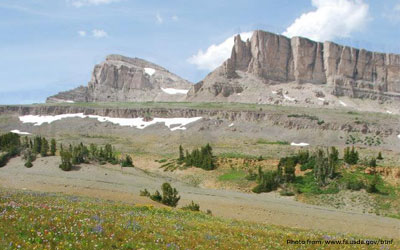 Located in Western Wyoming, the Bridger-Teton is comprised of more than 3.4 million acres of public lands. With its pristine watersheds, abundant wildlife and immense wildlands, the Bridger-Teton National Forest comprises a large part of the Greater Yellowstone Ecosystem – the largest intact ecosystem in the lower 48 United States. (http://www.fs.usda.gov/btnf) in Wyoming on the Fontenelle Fire
Located in Western Wyoming, the Bridger-Teton is comprised of more than 3.4 million acres of public lands. With its pristine watersheds, abundant wildlife and immense wildlands, the Bridger-Teton National Forest comprises a large part of the Greater Yellowstone Ecosystem – the largest intact ecosystem in the lower 48 United States. (http://www.fs.usda.gov/btnf) in Wyoming on the Fontenelle Fire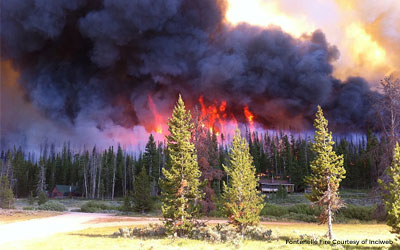 The Fontenelle Fire began on June 24, 2012 and is located approximately 18 miles west of Big Piney, Wyoming, mainly in the Bridger-Teton National Forest and BLM High Desert District with some state and private lands affected. The fire was managed under a full suppression strategy. The fire was declared out on October 25. (http://inciweb.nwcg.gov/incident/2934) as it was just kind of getting out of initial attack
The Fontenelle Fire began on June 24, 2012 and is located approximately 18 miles west of Big Piney, Wyoming, mainly in the Bridger-Teton National Forest and BLM High Desert District with some state and private lands affected. The fire was managed under a full suppression strategy. The fire was declared out on October 25. (http://inciweb.nwcg.gov/incident/2934) as it was just kind of getting out of initial attack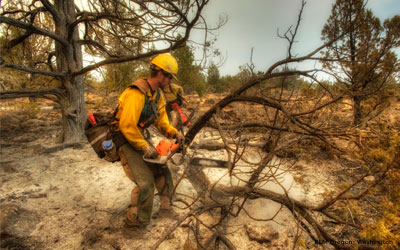 NWCG Definition of Initial Attack (IA): A planned response to a wildfire given the wildfire’s potential fire behavior. The objective of initial attack is to stop the fire and put it out in a manner consistent with firefighter and public safety and values to be protected.. They knew at some point they were going to need some help and we showed up at the right time. It was the first day of red flags NWCG Definition of Red Flag Warning: Term used by fire weather forecasters to alert forecast users to an ongoing or imminent critical fire weather pattern. and it was in lodge pole
NWCG Definition of Initial Attack (IA): A planned response to a wildfire given the wildfire’s potential fire behavior. The objective of initial attack is to stop the fire and put it out in a manner consistent with firefighter and public safety and values to be protected.. They knew at some point they were going to need some help and we showed up at the right time. It was the first day of red flags NWCG Definition of Red Flag Warning: Term used by fire weather forecasters to alert forecast users to an ongoing or imminent critical fire weather pattern. and it was in lodge pole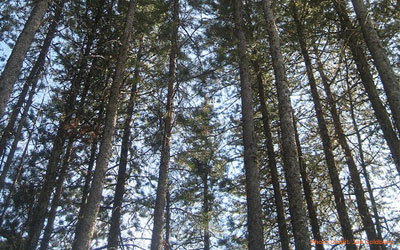 Pinus contorta is a fire-dependent species, requiring wildfires to maintain healthy populations of diverse ages. The bark of the lodgepole pine is fairly thin, minimizing the tree’s defense to fire; however, the heat of these closed-cone pine forest rejuvenating fires open the cones to release the seeds. This allows the species to regenerate and maintain its place in the forest habitat. “The Interaction of Fire, Fuels and Climate across Rocky Mountain Forests”. BioScience 54 (7): 661–76., where they were starting to get some of that bug kill
Pinus contorta is a fire-dependent species, requiring wildfires to maintain healthy populations of diverse ages. The bark of the lodgepole pine is fairly thin, minimizing the tree’s defense to fire; however, the heat of these closed-cone pine forest rejuvenating fires open the cones to release the seeds. This allows the species to regenerate and maintain its place in the forest habitat. “The Interaction of Fire, Fuels and Climate across Rocky Mountain Forests”. BioScience 54 (7): 661–76., where they were starting to get some of that bug kill More than 1.5 million acres of forest in northern Colorado and southern Wyoming are affected by the mountain pine beetle epidemic. Mountain pine beetles are killing pine and spruce trees throughout the Rocky Mountains and western U.S. at an unprecedented rate. The mass of dead trees following beetle epidemics create severe falling and fire hazards. (USFS).
More than 1.5 million acres of forest in northern Colorado and southern Wyoming are affected by the mountain pine beetle epidemic. Mountain pine beetles are killing pine and spruce trees throughout the Rocky Mountains and western U.S. at an unprecedented rate. The mass of dead trees following beetle epidemics create severe falling and fire hazards. (USFS).
So, we saw some real extreme fire behavior on that fire — from the moment we got there when it was probably, I don’t know, less the a hundred acres and watched it make some pretty impressive runs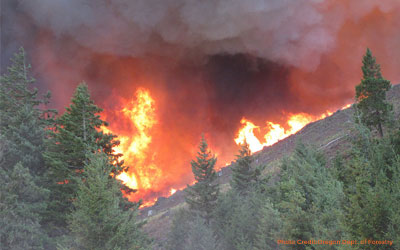 NWCG Definition of Run (Of a Fire): Rapid advance of the head of a fire, characterized by a marked transition in fireline intensity and rate of spread with respect to that noted before and after the advance..
NWCG Definition of Run (Of a Fire): Rapid advance of the head of a fire, characterized by a marked transition in fireline intensity and rate of spread with respect to that noted before and after the advance..
We spent the first week there—real long hard shift with pretty hairy burnouts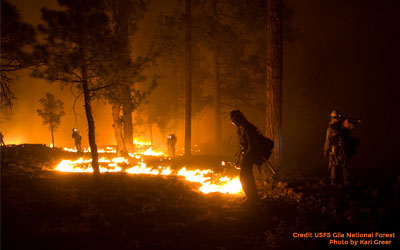 NWCG Definition of Firing Out (often called burning out): The act of setting fire to unburned fuels located between the control line and main fire in burning out operations.—like, over-slung
NWCG Definition of Firing Out (often called burning out): The act of setting fire to unburned fuels located between the control line and main fire in burning out operations.—like, over-slung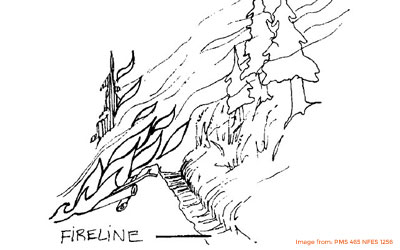 Fireline that is located mid-slope, above the main fire. along roads, where the trees…you can feel even a single tree torch
Fireline that is located mid-slope, above the main fire. along roads, where the trees…you can feel even a single tree torch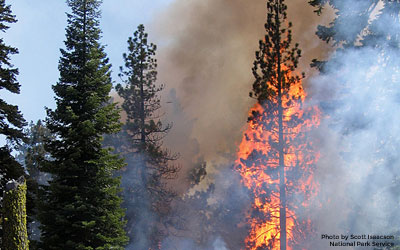 NWCG Definition of Torch: Ignition and subsequent envelopment in flames, usually from bottom to top, of a tree or small group of trees.. Really feel these trees just exploding with power. You know, it really kind of—it gets you on the edge and the hair stands up, knowing that you have to have everything dialed, and know where everyone is at at any given time. And it finally got to a point in those long days and really extended… it was getting hard to get out of the sleeping bag in the mornings, like by day seven.
NWCG Definition of Torch: Ignition and subsequent envelopment in flames, usually from bottom to top, of a tree or small group of trees.. Really feel these trees just exploding with power. You know, it really kind of—it gets you on the edge and the hair stands up, knowing that you have to have everything dialed, and know where everyone is at at any given time. And it finally got to a point in those long days and really extended… it was getting hard to get out of the sleeping bag in the mornings, like by day seven.
We bounced to another divisionNWCG Definition of Division: Divisions are used to divide an incident into geographical areas of operation.; it was a piece of the fire we hadn’t seen [before] and we pulled up and knew it was (more or less) kind of the direction that the fire had been heading for the last week. So, we pull up to this area and there are these really nice cabins that you know have probably been passed down for generations. You could see they had been working for a few days, setting up pumps NWCG Definition of Portable Pump: Small gasoline-driven pump that can be carried to a water source by one or two firefighters or other conveyance over difficult terrain. and getting things in place for structure protection
NWCG Definition of Portable Pump: Small gasoline-driven pump that can be carried to a water source by one or two firefighters or other conveyance over difficult terrain. and getting things in place for structure protection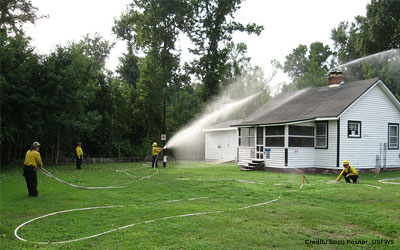 Tactics focused on providing wildland fire structure protection.. How they were going to go about it, they didn’t know. They were calling us in there to take a look, knowing that the fire (potentially that day) was going to get to that point.
Tactics focused on providing wildland fire structure protection.. How they were going to go about it, they didn’t know. They were calling us in there to take a look, knowing that the fire (potentially that day) was going to get to that point.
They had a lookout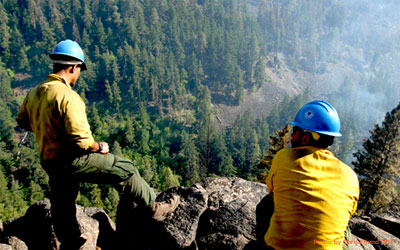 NWCG Definition for Lookout: A fire crew member assigned to observe the fire and warn the crew when there is danger of becoming trapped. up between us and the fire, saying “yeah, it’s down in the drainage getting ready to run up this side” and that’s all it’s going to take to get to these cabins. So, the plan was, we were going to go into more of a point source protection
NWCG Definition for Lookout: A fire crew member assigned to observe the fire and warn the crew when there is danger of becoming trapped. up between us and the fire, saying “yeah, it’s down in the drainage getting ready to run up this side” and that’s all it’s going to take to get to these cabins. So, the plan was, we were going to go into more of a point source protection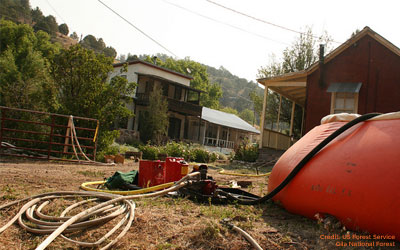 Point or Zone Protection involves protecting specific points from the fire while not actively trying to line the entire fire edge. Points being protected may be communities, individual homes, communication sites, areas of high resource value, etc. (ICS-209) mode and not worry, even though there was a pretty good solid road behind us, knowing how this fire had been moving throughout the crowns of these trees
Point or Zone Protection involves protecting specific points from the fire while not actively trying to line the entire fire edge. Points being protected may be communities, individual homes, communication sites, areas of high resource value, etc. (ICS-209) mode and not worry, even though there was a pretty good solid road behind us, knowing how this fire had been moving throughout the crowns of these trees NWCG Definition for Crown Fire: A fire that advances from top to top of trees or shrubs more or less independent of a surface fire. Crown fires are sometimes classed as running or dependent to distinguish the degree of independence from the surface fire. every day, that we probably weren’t going to hold the road, but we were going to do what we could to save those cabins.
NWCG Definition for Crown Fire: A fire that advances from top to top of trees or shrubs more or less independent of a surface fire. Crown fires are sometimes classed as running or dependent to distinguish the degree of independence from the surface fire. every day, that we probably weren’t going to hold the road, but we were going to do what we could to save those cabins.
Like I said, there were probably a dozen of them or so, all with out buildings, and coops and everything else. So, we were going to try to do it on our terms. Try to do a burn out around these cabins before the fire got there, knowing that we were probably going to lose it behind where we could chase it later on.
As quickly as we could, we started getting familiar with what was in place, the pumps and the crews that they had there to support us. We set up as quickly as we could and by the time everything was in place, of course, it’s one, two o’clock in the afternoonNWCG Definition for Burning Period: That part of each 24-hour period when fires spread most rapidly.. We had a quick briefing with the crew and got into place to start burning out around these cabins. I was holding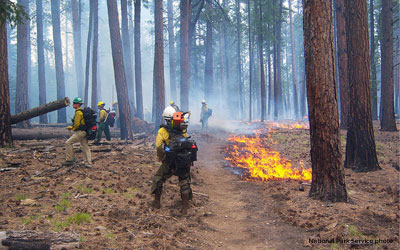 Holding resources are used to identify and extinguish spot fires resulting from firing operations.; I wasn’t lighting
Holding resources are used to identify and extinguish spot fires resulting from firing operations.; I wasn’t lighting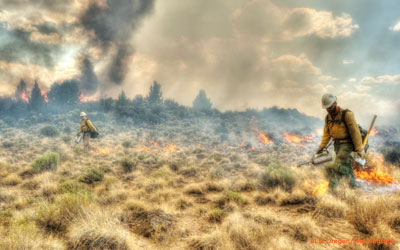 A Lighter or Burner is responsible for implementing the firing techniques during a burning operation (generally using a firing device such as a drip torch or fussee) that day. I was a Squad Leader, of course, trying to get people in the right place, extendingHolding resources are responsible for covering the entire span of the firing operation to ensure that risk from slop-overs and spot fires is mitigated. This typically requires patrolling the fireline and expanding (or extending) the spacing between holding resources in order to cover a wider area., and then kind of [working as a] liaison with the type two crewsCrews are differentiated between Type 1, Type 2 and Type 3 crews based on experience, leadership and availability. Each crew is comprised of between 18-20 men and women. (NPS) I.e., Hotshot Crews are Type 1 crews. spraying water on the cabins.
A Lighter or Burner is responsible for implementing the firing techniques during a burning operation (generally using a firing device such as a drip torch or fussee) that day. I was a Squad Leader, of course, trying to get people in the right place, extendingHolding resources are responsible for covering the entire span of the firing operation to ensure that risk from slop-overs and spot fires is mitigated. This typically requires patrolling the fireline and expanding (or extending) the spacing between holding resources in order to cover a wider area., and then kind of [working as a] liaison with the type two crewsCrews are differentiated between Type 1, Type 2 and Type 3 crews based on experience, leadership and availability. Each crew is comprised of between 18-20 men and women. (NPS) I.e., Hotshot Crews are Type 1 crews. spraying water on the cabins.
This fire, by the time we lit our back burn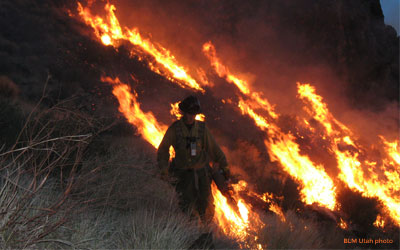 NWCG Definition for Backburn (Backfire): A fire set along the inner edge of a fireline to consume the fuel in the path of a wildfire or change the direction of force of the fire’s convection column. and the main fire came, they came together right on the top of this ridge. It was the most impressive, explosive fire behavior. I mean, you know, three hundred foot flame lengths, a wall of this fire up in green/dead trees, it didn’t matter. We had a lookout actually across on the next ridge behind us and he’s taking photos of this thing and it’s just…something you can’t really grasp or believe until you’ve seen it…how much fire there was. We had a really green, big open field
NWCG Definition for Backburn (Backfire): A fire set along the inner edge of a fireline to consume the fuel in the path of a wildfire or change the direction of force of the fire’s convection column. and the main fire came, they came together right on the top of this ridge. It was the most impressive, explosive fire behavior. I mean, you know, three hundred foot flame lengths, a wall of this fire up in green/dead trees, it didn’t matter. We had a lookout actually across on the next ridge behind us and he’s taking photos of this thing and it’s just…something you can’t really grasp or believe until you’ve seen it…how much fire there was. We had a really green, big open field NWCG Definition for Safety Zone: An area cleared of flammable materials used for escape in the event the line is outflanked or in case a spot fire causes fuels outside the control line to render the line unsafe. In firing operations, crews progress so as to maintain a safety zone close at hand allowing the fuels inside the control line to be consumed before going ahead. Safety zones may also be constructed as integral parts of fuelbreaks; they are greatly enlarged areas which can be used with relative safety by firefighters and their equipment in the event of blowup in the vicinity. Photo of open area in front of the Fontenelle Fire.; we were all comfortable, but just to be that close to that impressive of a fire was something I had never seen before.
NWCG Definition for Safety Zone: An area cleared of flammable materials used for escape in the event the line is outflanked or in case a spot fire causes fuels outside the control line to render the line unsafe. In firing operations, crews progress so as to maintain a safety zone close at hand allowing the fuels inside the control line to be consumed before going ahead. Safety zones may also be constructed as integral parts of fuelbreaks; they are greatly enlarged areas which can be used with relative safety by firefighters and their equipment in the event of blowup in the vicinity. Photo of open area in front of the Fontenelle Fire.; we were all comfortable, but just to be that close to that impressive of a fire was something I had never seen before.
Definitely looking back now, you know, I am not sure I will ever see that kind of fire again. It was in timber; kind of that area ignition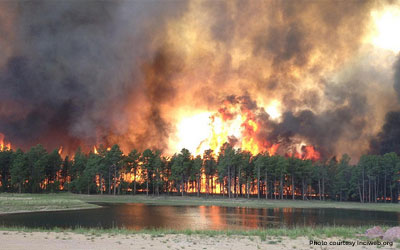 NWCG Definition for Area Ignition: Ignition of several individual fires throughout an area, either simultaneously or in rapid succession, and so spaced that they add to and influence the main body of the fire to produce a hot, fast-spreading fire condition. Also called simultaneous ignition. where it wasn’t a matter of fire kind of carrying through to the next [tree] and torching. It was just, once everything decided to go, the whole slope went at once. You could feel it; you could hear it; it was really intense.
NWCG Definition for Area Ignition: Ignition of several individual fires throughout an area, either simultaneously or in rapid succession, and so spaced that they add to and influence the main body of the fire to produce a hot, fast-spreading fire condition. Also called simultaneous ignition. where it wasn’t a matter of fire kind of carrying through to the next [tree] and torching. It was just, once everything decided to go, the whole slope went at once. You could feel it; you could hear it; it was really intense.
Of course, we never intentionally slick off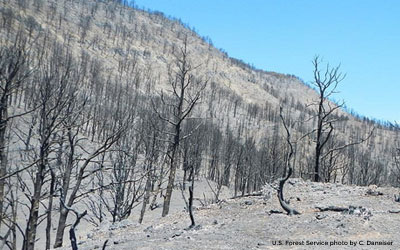 Sometimes called “nuking,” slicking off a hillside means firing off the vegetation with such high intensity fire that all foliage, as well as some heavier fuel, is consumed. This is not always ideal because it destabilizes (and sometime sterilizes) the soils. a hillside during a burnout on a wildfire; whatever we can do to try and bring it down [slowly with lower intensity]. Well, there was none of that on this fire. We had to just get it done the quickest, safest way possible. And of course, that whole slope was just black sticks standing. It took just hours until it was just a little bit of smoke coming out of there because it burned so hot and fast. I kind of felt bad that it looked like it did, after it was all said and done, but they were so grateful that we saved every cabin.
Sometimes called “nuking,” slicking off a hillside means firing off the vegetation with such high intensity fire that all foliage, as well as some heavier fuel, is consumed. This is not always ideal because it destabilizes (and sometime sterilizes) the soils. a hillside during a burnout on a wildfire; whatever we can do to try and bring it down [slowly with lower intensity]. Well, there was none of that on this fire. We had to just get it done the quickest, safest way possible. And of course, that whole slope was just black sticks standing. It took just hours until it was just a little bit of smoke coming out of there because it burned so hot and fast. I kind of felt bad that it looked like it did, after it was all said and done, but they were so grateful that we saved every cabin.
In fact, there were people talking, of course, amongst themselves, “you know, what are the odds of all of them—how many of these ten or twelve are going to make it? You know, half? All of them? None of them?” No one really knew what was really going to happen. And as optimistic as I feel like I am, I really didn’t have a good feeling that we were going to save them all.
Sure enough, after it was all said and done, every cabin was still standing, every outbuilding; the whole deal. It was a great feeling for the crew; we really felt accomplished after that was all done. They kind of gave us a pat-on-the-back, the team NWCG Definition for Incident Management Team: The incident commander and appropriate general and command staff personnel assigned to an incident. did, after it was all done (with a little certificate and all this stuff). That was really neat to see that come together and the big thing there was just seeing that impressive of a fire. It was pretty incredible.
NWCG Definition for Incident Management Team: The incident commander and appropriate general and command staff personnel assigned to an incident. did, after it was all done (with a little certificate and all this stuff). That was really neat to see that come together and the big thing there was just seeing that impressive of a fire. It was pretty incredible.